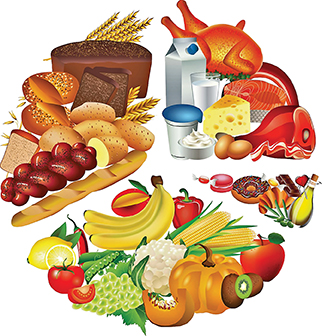What’s on YOUR plate?
Posted on July 31, 2015 by bob in In Every Life
In recent months, pieces in this In Every Life section have focused on maintaining activity, hydration, and safe handling of fresh foods. A related issue is overall diet planning to assure adequate protein intake. Carbohydrates, fats, and protein comprise the three food types. 
Carbohydrates are obtained from fruits, vegetables, potatoes, corn, milk, breads, cereals, pasta, rice, and sugars (such as in sodas, cakes, cookies, pastries, other desserts, or honey).
Fats are in oils, shortening, butter or margarine, cream, seeds/nuts, coconut, and may be a component in meats or other foods. Recommendations are to reduce saturated fat (solid at room temperature) and trans-fats (used in many commercially baked or fried foods), and to use unsaturated fat sources (liquid at room temperature).
Lean protein sources include seafood, lean meat/poultry, lentils, beans, peas, nuts, seeds, eggs, tofu, and hummus. Some people are unable to eat nuts & seeds due to allergy or diverticulosis, while for others unsalted nuts or nut butters are a quick source for protein.
Although some may avoid meat or nuts due to difficulty chewing, inadequate protein in the diet can decrease components needed to replace and maintain muscle. The term sarcopenia refers to the replacement of muscle fibers with fat, similar to marbling in a piece of beef. Fat does not respond to nerve impulses to expand and contract, causing a decrease in muscle strength. (Inactivity also causes loss in muscle strength, and was discussed a few months ago.) The recommended daily value for protein is approximately 5½ ounces, preferably divided throughout the day.
Another way to calculate protein intake is approximately 20 grams for each of three meals, to total about 60 grams per day. Research findings have not shown any increased benefit in more than 30 grams intake at one time. Higher amounts of protein will result in breakdown of more of protein’s components, which may cause damage to the kidneys during excretion.
Food labels include the grams of protein. Be sure to look at the serving size of the container to accurately calculate how much of all of the components are in the actual amount you are eating. For example a package of nuts may list two servings per package. The number on the label for protein (and all of the components) would need to be doubled if you ate the entire package. A quick way to determine from a label if a food is low in protein is if it is less than 5% of the recommended Daily Values, while foods over 20% are considered high in protein.
Labels refer to percent of recommended Daily Values (%DV) based on a 2000 calorie diet. However, a smaller person or one who is more sedentary may only require, for example, 1200, 1400 or 1600 calories per day to avoid weight gain. The same bag of nuts would provide a higher %DV for this person than what is listed on the label. For more information, visit https://www.nia.nih.gov/health/publication/whats-your-plate/protein-carbohydrates-fats or http://www.ncbi.nlm.nih.gov/pmc/articles/PMC2760315.
Taking care of yourself is vital for healthy aging. Key components of self-care include keeping active to maintain muscle function, drinking water, safely handling foods, and selecting healthy foods to provide protein throughout the day. Be aware of all of these major points as you enjoy a great rest of the summer!
Arlene H. Morris, EdD, RN, CNE, is Professor of Nursing, Auburn Montgomery School of Nursing, and Immediate Past President of the AL State Nurses Association. Reach her at amorris@aum.edu.










